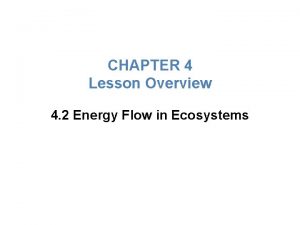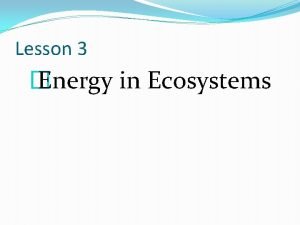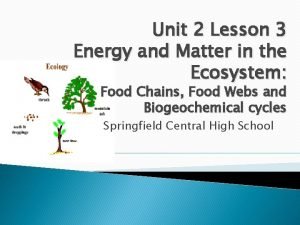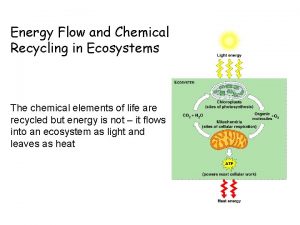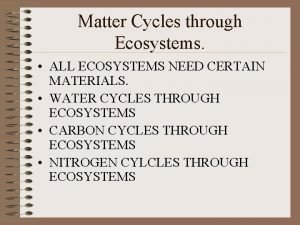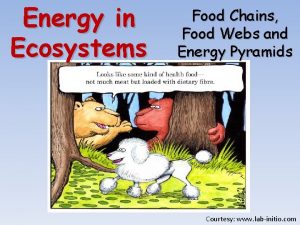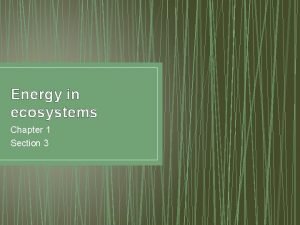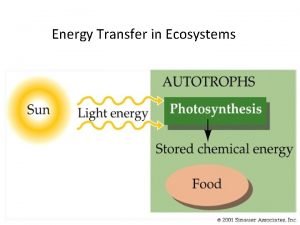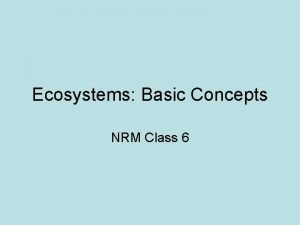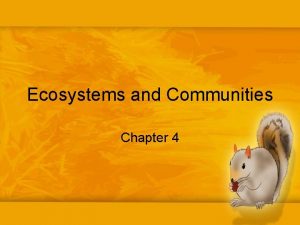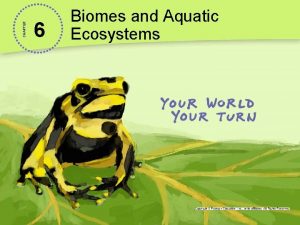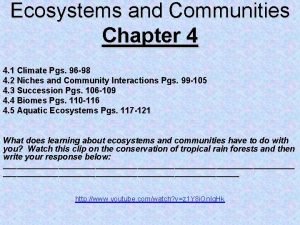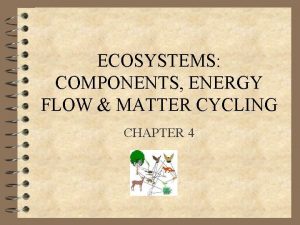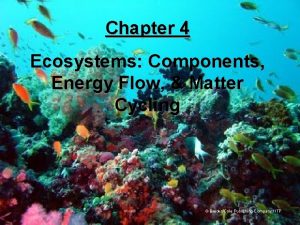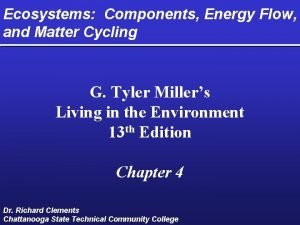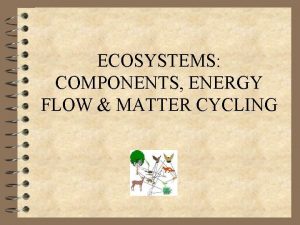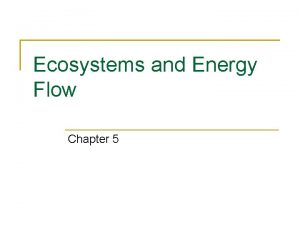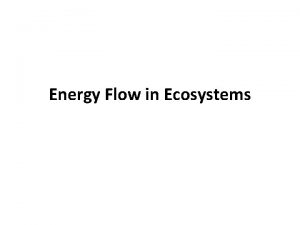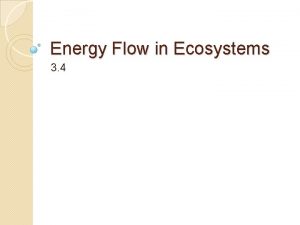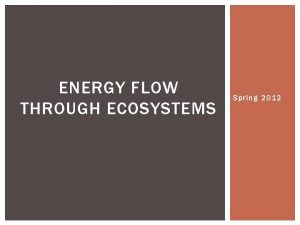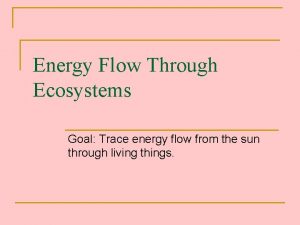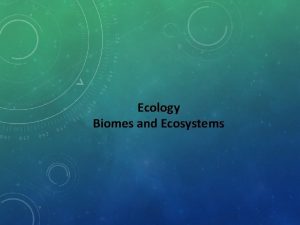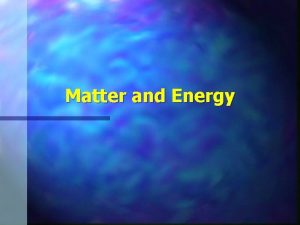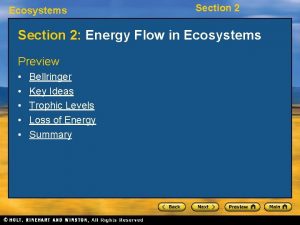Chapter 4 Ecosystems Components Energy Flow and Matter























- Slides: 23

Chapter 4: Ecosystems: Components, Energy Flow, and Matter Cycling “The Earth’s thin film of living matter is sustained by grand-scale cycles of energy and chemical elements. ” G. Evelyn Hutchinson

What Is Ecology The study of how organisms interact with one another and with their nonliving environment. Connections in nature

Important Terminology (Biology Review) Organism Any form of life Cell Eukaryotic cell Prokaryotic cell Species Groups of organisms Population Group of interacting individuals of the same species that occupy a specific area at the same time Genetic Diversity Variance in genetic makeup of populations Habitat Where a population normally lives

Levels Of Organization

Earth’s Systems Atmosphere Troposphere/Stratosphere Hydrosphere Liquid water Ice, icebergs, frozen soil layers Water vapor Lithosphere Crust and upper mantle Biosphere Where living organisms exist

Life On Earth Life depends on three interconnected factors 1. One-way flow of high-quality energy from the sun 2. Cycling of Matter 3. Gravity

Interconnected Factors

Ecosystem Concepts and Biomes Terrestrial portion of the biosphere has been classified into biomes. These biomes are characterized by: Distinct climate • Long-term patters of weather Specific landforms

Characteristics of Ecosystems No distinct boundaries nor self-contained Abiotic Factors Range of tolerance Limiting factor Biotic Factors Producers – autotrophs Consumers - heterotrophs • Herbivores • Omnivores • decomposers Carnivores Scavengers

Food Webs and Energy Flow Food Chain Food Web

Pyramids of Energy Flow

Biogeochemical Cycles Nutrient cycles – the nutrient atoms, ions, and molecules that organisms need to live, grow, and reproduce are continuously cycled from the nonliving environment and then back again.

Water Cycle

Water Cycle – Human Impacts Withdrawing large quantities of fresh water from streams, lakes, and underground sources. Clearing vegetation from land for agriculture, mining, road and building construction, and other activities. Modifying water quality

Carbon Cycle

Carbon Cycle – Human Impacts Clearing trees and other plants that absorb CO 2 through photosynthesis Adding large amounts of CO 2 by burning fossil fuels and wood

Nitrogen Cycle

Nitrogen Cycle – Human Impacts Adding large amounts of nitric acid into the atmosphere when we burn any fuel. Adding nitrous oxide to the atmosphere through the action of anaerobic bacteria on livestock wastes and commercial inorganic fertilizers Removing nitrogen from topsoil

Phosphorous Cycle

Phosphorous Cycle – Human Impacts Mining large quantities of phosphate rock for use in commercial inorganic fertilizers and detergents Reducing the available phosphate in tropical forests by removing trees. Adding excess phosphate to aquatic ecosystems: Runoff of animal wastes Runoff of commercial phosphate Discharge of municipal sewage

Sulfur Cycle

Sulfur Cycle – Human Impact Burning sulfur-containing coal and oil Refining sulfur-containing petroleum Using smelting to convert sulfur compounds of metallic minerals

Ecosystem Services “All things come from earth, and to earth they all return. Menander (342 -290 B. C. )
 Chapter 4 lesson 2 energy flow in ecosystems
Chapter 4 lesson 2 energy flow in ecosystems Energy in ecosystems lesson 3 answer key
Energy in ecosystems lesson 3 answer key Lesson 3 energy and matter in ecosystems answer key
Lesson 3 energy and matter in ecosystems answer key Energy naturally flows from warmer matter to cooler matter
Energy naturally flows from warmer matter to cooler matter Flow of energy vs flow of matter
Flow of energy vs flow of matter Flow of energy
Flow of energy Lesson 4: energy flow in ecosystems
Lesson 4: energy flow in ecosystems Section 1 energy flow in ecosystems
Section 1 energy flow in ecosystems Chapter 42 ecosystems and energy
Chapter 42 ecosystems and energy Matter cycling in ecosystems
Matter cycling in ecosystems How does energy flow in an ecosystem
How does energy flow in an ecosystem Lab food chains and energy in ecosystems
Lab food chains and energy in ecosystems Chapter 2 section 1 classifying matter answers
Chapter 2 section 1 classifying matter answers Section 3 energy in ecosystems
Section 3 energy in ecosystems Do birds eat squirrels
Do birds eat squirrels Energy flow through an ecosystem is ----- *
Energy flow through an ecosystem is ----- * Provides practically all the energy for ecosystems
Provides practically all the energy for ecosystems Chapter 4 ecosystems and communities
Chapter 4 ecosystems and communities Savanna biome plants
Savanna biome plants 6 biomes and aquatic ecosystems answers
6 biomes and aquatic ecosystems answers Chapter 55 ecosystems and restoration ecology
Chapter 55 ecosystems and restoration ecology Chapter 3 lesson 3 biomes and aquatic ecosystems
Chapter 3 lesson 3 biomes and aquatic ecosystems Chapter 55 ecosystems and restoration ecology
Chapter 55 ecosystems and restoration ecology Parasitism examples
Parasitism examples
